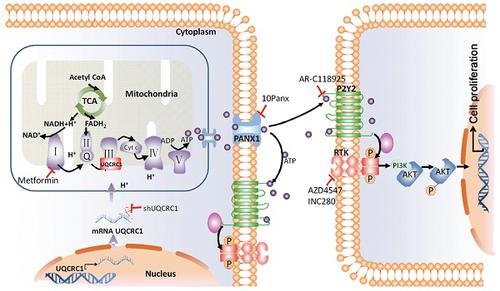Theranostics ( IF 12.4 ) Pub Date : 2020-01-01 , DOI: 10.7150/thno.38704 Qing Wang 1 , Mengge Li 1 , Yu Gan 1 , Shuheng Jiang 1 , Jie Qiao 1 , Wei Zhang 1 , Yingchao Fan 1 , Yuling Shen 1, 2 , Yanfang Song 1 , Zihong Meng 1 , Ming Yao 1 , Jianren Gu 1 , Zhigang Zhang 1 , Hong Tu 1

|
Purpose: Pancreatic ductal adenocarcinoma (PDAC) is a malignant disease with a poor prognosis. One prominent aspect of PDAC that contributes to its aggressive behavior is its altered cellular metabolism. The aim of this study was to characterize the oncogenic effects of ubiquinol-cytochrome c reductase core protein I (UQCRC1), a key component of mitochondrial complex III, in PDAC development and to assess its potential as a therapeutic target for PDAC.
Experimental Design: The expression of UQCRC1 in human PDAC tissues and p48-Cre/p53Flox/WT/LSL-KrasG12D (KPC) mouse pancreatic intraepithelial neoplasias (PanINs) was determined by immunohistochemistry. The role of UQCRC1 in promoting PDAC growth was evaluated in vitro in PANC-1 and CFPAC-1 cells and in vivo in transplanted mouse models of PDAC. Extracellular flux and RNA-Seq analyses were applied to investigate the mechanism of UQCRC1 in the regulation of mitochondrial metabolism and PDAC cell growth. The therapeutic potential of UQCRC1 in PDAC was assessed by knockdown of UQCRC1 using an RNA interference approach.
Results: UQCRC1 expression showed a gradual increase during the progression from PanIN stages to PDAC in KPC mice. Elevated expression of UQCRC1 was observed in 72.3% of PDAC cases and was correlated with poor prognosis of the disease. UQCRC1 promoted PDAC cell growth in both in vitro experiments and in vivo subcutaneous and orthotopic mouse models. UQCRC1 overexpression resulted in increased mitochondrial oxidative phosphorylation (OXPHOS) and ATP production. The overproduced ATP was released into the extracellular space via the pannexin 1 channel and then functioned as an autocrine or paracrine agent to promote cell proliferation through the ATP/P2Y2-RTK/AKT axis. UQCRC1 knockdown or ATP release blockage could effectively inhibit PDAC growth.
Conclusion: UQCRC1 has a protumor function and may serve as a potential prognostic marker and therapeutic target for PDAC.
中文翻译:

线粒体蛋白UQCRC1具有致癌性,是胰腺癌的潜在治疗靶标。
目的:胰腺导管腺癌(PDAC)是一种预后较差的恶性疾病。PDAC有助于其侵略行为的一个突出方面是其细胞代谢的改变。这项研究的目的是表征线粒体复合体III的关键成分泛醇-细胞色素C还原酶核心蛋白I(UQCRC1)在PDAC的发展中的致癌作用,并评估其作为PDAC的治疗靶标的潜力。
实验设计:通过免疫组织化学测定UQCRC1在人PDAC组织和p48-Cre / p53Flox / WT / LSL-KrasG12D(KPC)小鼠胰腺上皮内瘤变(PanINs)中的表达。在体外在PANC-1和CFPAC-1细胞中以及在体内移植的PDAC小鼠模型中评估了UQCRC1在促进PDAC生长中的作用。应用细胞外通量和RNA-Seq分析来研究UQCRC1调节线粒体代谢和PDAC细胞生长的机制。通过使用RNA干扰方法敲低UQCRC1来评估UQCRC1在PDAC中的治疗潜力。
结果:在KPC小鼠中,从PanIN阶段到PDAC的过程中,UQCRC1表达逐渐增加。在72.3%的PDAC病例中观察到UQCRC1的表达升高,并且与疾病的预后不良有关。在体外实验以及体内皮下和原位小鼠模型中,UQCRC1均可促进PDAC细胞的生长。UQCRC1过表达导致线粒体氧化磷酸化(OXPHOS)和ATP产生增加。过量产生的ATP通过pannexin 1通道释放到细胞外空间,然后用作自分泌或旁分泌药物,通过ATP / P2Y2-RTK / AKT轴促进细胞增殖。UQCRC1敲低或ATP释放阻滞可有效抑制PDAC的生长。
结论:UQCRC1具有肿瘤功能,可作为PDAC的潜在预后标志物和治疗靶标。



























 京公网安备 11010802027423号
京公网安备 11010802027423号